A cashier in a store said to me today, "College professors have the cushiest jobs." Or maybe it was, "easy jobs."
I didn't clench my teeth physically, but I did the mental equivalent. I was really ticked. I replied, "You don't know anything about my job." It took a lot of willpower not to say more.
30 September 2007
19 September 2007
Life imitating art scaring the pants off of life
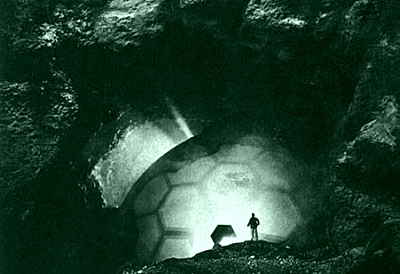 I watch and read science fiction. Have done as long as I can remember.
I watch and read science fiction. Have done as long as I can remember.Last night, I watched Episode 2 of Torchwood, about the havoc wrecked after a meteorite hits.
War of the Worlds movie adaptation. People thought the Martian spaceships were meteors.
It Came From Outer Space. In a meteorite.
And there was the "Lonesome Death of Jordy Verrill" segment of Creepshow.
This scares me.
17 September 2007
Classic graphics #3: The somatosensory cortex
 When I lived in Montreal, I had the unusual experience of living in a city where a scientist was not just known (unusual enough), but frankly, revered. That scientist was Wilder Penfield.
When I lived in Montreal, I had the unusual experience of living in a city where a scientist was not just known (unusual enough), but frankly, revered. That scientist was Wilder Penfield.I worked at McGill University, I worked on Dr. Wilder Penfield Avenue. And when I went to some talks at the Montreal Neurological Institute, I heard a speaker talk about having the chance to meet with "the great man," with no hint of irony.
Although it was probably Penfield's reputation as a surgeon that cemented him in the minds of Montrealers as a great individual, one of his most lasting scientific contributions is the map of the somatosensory cortex. This is truly a classic figure, that has been reproduced many times, and is virtually a standard in any textbook that even mentions brains.
Indeed, this picture has been used to study how textbooks copy from one another. In one redrawing of this diagram, a right hand got drawn onto the left side of a body (or vice versa). The error was then propagated in textbook after textbook.
I think this diagram comes from The Cerebral Cortex of Man: A Clinical Study of Localization of Function, co-authored with Ted Rasmussen and published in 1950.
The one up top shows half the story, namely the motor cortex. An equivalent diagram is available showing the sensory side.
What makes this figure a classic is that it uses images so successfully to tell the story. Wrapping the images of the highly distorted body takes something that is actually very abstract and makes it much more easy to relate to. If I am not mistaken, Penfield made these maps during open brain surgery, often with the patient awake. He would stimulate these regions, and observed what the patient did in response to the stimulation (on the motor side), or what the patient reported.
The diagram compiles all those observations of various body movements and miscellaneous reports of sensations.
 This edited version of the figure has all the same information as the top one, only using text labels. Indeed, the text labels on the top diagram are almost redundant. But it is clearly nowhere near as compelling as the one showing all the bits of body, with some regions enlarged and some shrunk.
This edited version of the figure has all the same information as the top one, only using text labels. Indeed, the text labels on the top diagram are almost redundant. But it is clearly nowhere near as compelling as the one showing all the bits of body, with some regions enlarged and some shrunk.Some people have gone the other way, and created representations of a body sized proportionately to the area of the brain that represents them. In my estimation, these are not as powerful, either.
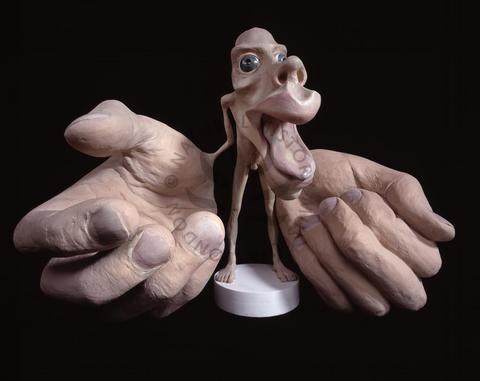 The distorted body (sometimes called a homunculus, which means little man) is now isolated from the brain. You lose that sense that this is something tied to how the brain works. Such representations have a certain interest, but I don't think they make the scientific point about how our body is represented in the brain anywhere near as well as the original.
The distorted body (sometimes called a homunculus, which means little man) is now isolated from the brain. You lose that sense that this is something tied to how the brain works. Such representations have a certain interest, but I don't think they make the scientific point about how our body is represented in the brain anywhere near as well as the original.Additional, 15 February 2015: Ran across this academic article describing how this diagram changed over time. The first effort, in 1937, was confusing compared to the famous 1950 version.
Schott GD. 1993. Penfield’s homunculus: a note on cerebral cartography. Journal of Neurology, Neurosurgery, and Psychiatry 56 329-333. http://jnnp.bmj.com/content/56/4/329.full.pdf
16 September 2007
Villainy I
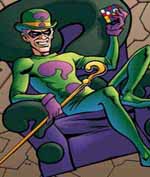 Your results: You are Riddler
Your results: You are RiddlerRiddle me that, riddle me this, who is obsessed with having a battle of wits??
| Riddler | 75% | |
| Dark Phoenix | 69% | |
| Apocalypse | 68% | |
| The Joker | 65% | |
| Poison Ivy | 65% | |
| Magneto | 64% | |
| Mr. Freeze | 61% | |
| Dr. Doom | 61% | |
| Venom | 55% | |
| Catwoman | 54% | |
| Juggernaut | 53% | |
| Lex Luthor | 51% | |
| Mystique | 45% | |
| Green Goblin | 33% | |
| Kingpin | 33% | |
| Two-Face | 29% |
Click here to take the "Which Super Villain am I?" quiz...
And it's The Riddler, thank you.
15 September 2007
Did I miss my calling?
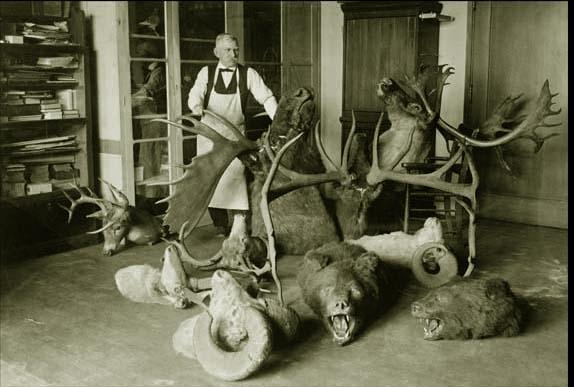 Careers I would apparently like...
Careers I would apparently like...1. Taxidermist (What?!)
2. Desktop Publisher (Kind of did that)
3. Veterinary Technician
4. Industrial Designer
5. Cartoonist / Comic Illustrator (Done a bit of that)
6. Animator
7. Fashion Designer
8. Costume Designer
9. Set Designer
10. Botanist (Getting close)
11. Artist
12. Graphic Designer
13. Paleontologist
14. Critic (Sort of did that)
15. Writer (Does blogging count?)
16. Computer Animator
17. Biologist
18. Political Aide
19. Activist
20. Communications Specialist
21. Market Research Analyst
22. Public Policy Analyst
23. Print Journalist
24. Website Designer
25. Interior Designer (Could you picture me on Trading Spaces?)
26. Translator
27. Medical Illustrator
28. Technical Writer
29. Animal Breeder
30. Craftsperson
31. Potter
32. Marine Biologist
33. Public Relations Specialist
34. Veterinarian
35. Zoologist
36. Criminologist
37. Anthropologist
38. Professor
39. Biological Tech
40. Optometrist
This meme courtesy of John Wick.
13 September 2007
Lights out
A few minutes before five o'clock, the power went out in my office. My building. And I soon learned the power was off on the entire campus. It took a while to find out a transformer had gone out, and power wasn't coming back on in a few minutes.
At least this was at the end of the day. If it had been earlier, it would have been very disruptive to the site visit of the regional director for Beta Beta Beta. Students are trying to establish a chapter – they need a faculty advisor – and I said, “Okay.” So part of establishing a chapter is the visit, and I think that went well.
In other emergencies...
Our president had to go through major heart surgery unexpectedly. And we also just found out that one of our scheduled Science Symposium speakers for HESTEC has to cancel because he has to go in for major heart surgery (triple bypass). And our Beta Beta Beta visitor was the recipient of quadruple bypass surgery not too long ago.
At least this was at the end of the day. If it had been earlier, it would have been very disruptive to the site visit of the regional director for Beta Beta Beta. Students are trying to establish a chapter – they need a faculty advisor – and I said, “Okay.” So part of establishing a chapter is the visit, and I think that went well.
In other emergencies...
Our president had to go through major heart surgery unexpectedly. And we also just found out that one of our scheduled Science Symposium speakers for HESTEC has to cancel because he has to go in for major heart surgery (triple bypass). And our Beta Beta Beta visitor was the recipient of quadruple bypass surgery not too long ago.
12 September 2007
Another sad day
 Some become so famous that one one name is needed. Elvis. Madonna.
Some become so famous that one one name is needed. Elvis. Madonna.In the field of animal behaviour and psychology, most people knew about Alex.
Poor Alex died unexpectedly last week. When I saw a new story about a "famous parrot" dying, my heart sunk, because I knew there was only one parrot that it could be.
Alex was the African grey parrot that Irene Pepperberg had worked with for 30 years in her classic studies of comparative cognition. People had always known parrots were clever, but started to show just how clever. Categorization, counting, concepts... Work with Alex really started to undo a lot of the thinking that had permeated animal behaviour since the Clever Hans affair and the radical behaviourism of American psychology in the mid-20th century. For decades, anything that remotely smelled of "thinking" was exiled from scientific study in animals, and sometimes even humans.
Irene Pepperberg's work can be seen at the Alex Foundation.
08 September 2007
Classic graphics #2: Crayfish tailflips
 This particular picture is not famous outside of my own field. But it has been reproduced many times, and as such, I think warrants the classic designation.
This particular picture is not famous outside of my own field. But it has been reproduced many times, and as such, I think warrants the classic designation.Crayfish tailflipping was one of the first natural animal behaviours that neuroethology really cracked. It was one of the first cases where we could explain how the connections between the neurons explained a lot about how the behaviour of the animal worked.
One of the little oddities in the story of understanding the escape response of crayfish was that the major neurons involved were recognized back in the 1920s. These huge neurons became known as the lateral giant (LG) and medial giant (MG) neurons, but even in the flapper era, there was pretty strong evidence then these giant neurons were involved in tailflipping.
But it took over 40 years for people to explain why there were two sets of neurons involved in tailflipping. And they can be forgiven for not figuring this out quickly, because this behaviour is so blindingly fast, you can't make it out with the naked eye.
When people finally got around to using high speed film, the answer became clear. There wasn't one behaviour. There were two. There were two different kinds of tailflips, each triggered by a different set of neurons. (Actually, it turned out that there were three kinds of tailflips, but that's another story.)
What fascinates me about this particular figure (from Wine and Krasne, 1972) is that it was not the first to make this point. Priority is huge in science. Normally, the first to show anything gets priority, and hold a very strong sway on our imaginations. Ask someone who was the second person to climb Mount Everest, or the second person to fly solo across the Atlantic. Heck, I don't know.
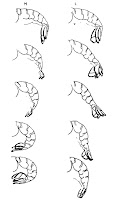 Just a few months earlier, in the same journal, another group of researchers led by Jim Larimer (which included my intellectual predecessor, Don Kennedy) published a picture that shows the same thing: that stimulating the different neurons generates different movements.
Just a few months earlier, in the same journal, another group of researchers led by Jim Larimer (which included my intellectual predecessor, Don Kennedy) published a picture that shows the same thing: that stimulating the different neurons generates different movements.In this case, I think it's pretty clear why the later picture became the canonical representation of crayfish escape behaviour: context. You see the stick tapping animal, and you see the whole animal, moving through space, rather than an isolated part of an animal being held static. The advantages of this are huge.
The top diagram makes it forcefully clear what advantage there is to having two tailflips: both tailflips take the animal away from the source of the offending stimulus, but do so by throwing the animal in different directions. The crayfish jackknifes into the water when the LGs fire, but heads straight back when the MGs fire. You can sort of extrapolate that from what's shown in the earlier figure, but since you can't see where the stimulus would be, you don't have that immediate "Aha!" insight.
Sometimes, it isn't better to be first. It's better to be better.
References
Larimer, J. L., Eggleston, A. C., Masukawa, L. M. and Kennedy, D. (1971). The different connections and motor outputs of lateral and medial giant fibres in the crayfish. The Journal of Experimental Biology 54, 391-404.
Wine, J. J. and Krasne, F. B. (1972). The organization of escape behaviour in the crayfish. The Journal of Experimental Biology 56, 1-18.
Classic graphics#1: The Cartesian reflex
 One of my side interests is in graphics. And I'm curious about what makes an image famous. Particularly scientific images. So I'm going to try exploring that from time to time, focusing on my own field of interest, neurobiology.
One of my side interests is in graphics. And I'm curious about what makes an image famous. Particularly scientific images. So I'm going to try exploring that from time to time, focusing on my own field of interest, neurobiology.Over at the left is an image that I've seen reproduced many times. So often, in fact, that I'm having a hard time finding exactly the original source, to my embarrassment. It's from the work of René Descartes, 17th century French intellectual. I think it's from Treatise on Man, published around 1662 after Descartes' death.
I do not know if Descartes drew his own figures. I doubt it, because preparing woodcuts is a pretty specialized talent. And Descartes, I've heard, loved a life of luxury. I don't think he was the sort to handle woodcutting tools. Be that as it may...
What the figure is showing is Descartes' conception of how behaviour worked. It looks fairly modern. Even if you understand only a bit of modern biology, you might think, "You have a sensory stimulus, impulses travel up the spinal cord to the brain, are processed, and you get a withdrawal from the painful stimulus."
I think that's one reason why this particular diagram is famous: because it is almost eerily prescient.
And indeed, in broad strokes, that's what this is showing. Descartes was the first to develop a reflexive theory of behaviour, although I don't think he used the term "reflex." Because Descartes is so famous for his ideas on the soul, his arguments that much of behaviour -- even in humans -- is purely "push pull" sorts of automatic, reflexive responses is often overlooked.
That the picture looks quite modern in some ways actually sort of overshadows some important problems. Descartes had what I consider to be a pre-scientific concept of behaviour. The discovery of biological electricity was centuries away, so Descartes followed the ancients in thinking that behaviour was controlled through the movements of "animal spirits."
 Is the picture at top famous because of the idea that it shows? I don't think it's just that. Over to the left is another picture showing the same basic idea, again from Descartes, and I think even from the same book. Regardless, you see the same basic elements: a fire, an outstretched limb, and "animal spirit vessels" leading to the brain.
Is the picture at top famous because of the idea that it shows? I don't think it's just that. Over to the left is another picture showing the same basic idea, again from Descartes, and I think even from the same book. Regardless, you see the same basic elements: a fire, an outstretched limb, and "animal spirit vessels" leading to the brain.Yet this one I have not reproduced seen over and over again like the top one. I would say the top one is a classic, but the bottom one not. And here, the actual rendering of the diagram might be important in why this one isn't reproduced that often.
I find the second one is kind of disturbing. The figure has sort of babyish proportions. The torso sort of floats out of a cloak, which no obvious indications of a bottom half. Plus, the "animal spirit vessels" don't go right out to the fingers, making the idea that there's a connection between the stimulus and the person's brain harder to understand.
Or maybe the reason the top one is more famous is that editors are always looking for excuses to put in more nudes in their books.
07 September 2007
Oh, no.
I was just looking for something for another post I was writing, and boom, learned Barry Beyerstein was dead.
Geez.
I can't say I knew him well, but he was someone who did me some favours. When I was a grad student, he invited me over from UVic to SFU to give a talk to the BC Skeptics after reading an article I published in The Skeptical Inquirer. It was my first invited talk. Later, he was a special science guest at I-Con 2, a SF convention I helped organize in Victoria.
He was wonderfully friendly guy. I'm sorry I'll never get a chance to run into him again.
Additional, 20 March 2014: Here’s someone who heard Barry Beyerstein at I-Con 2, which, as I said, I was involved in organizing and inviting Barry to. He calls hearing Beyerstein speak, “a life-altering shock to me, a road to Damascus moment.”
Geez.
I can't say I knew him well, but he was someone who did me some favours. When I was a grad student, he invited me over from UVic to SFU to give a talk to the BC Skeptics after reading an article I published in The Skeptical Inquirer. It was my first invited talk. Later, he was a special science guest at I-Con 2, a SF convention I helped organize in Victoria.
He was wonderfully friendly guy. I'm sorry I'll never get a chance to run into him again.
Additional, 20 March 2014: Here’s someone who heard Barry Beyerstein at I-Con 2, which, as I said, I was involved in organizing and inviting Barry to. He calls hearing Beyerstein speak, “a life-altering shock to me, a road to Damascus moment.”
If only it were that easy to get rid of a cold
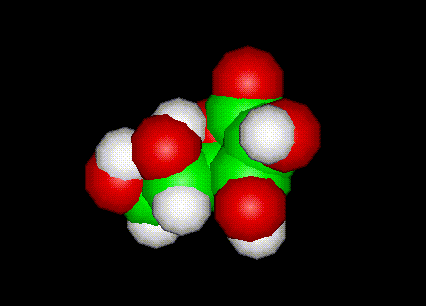 I have a cold. And being a guy, I am a crybaby about it. But even a simple cold gives a chance for some thinking about science.
I have a cold. And being a guy, I am a crybaby about it. But even a simple cold gives a chance for some thinking about science.Someone who stuck her head into my office said, "Drink some orange juice." While I like orange juice, the advice is wrong on two counts.
As far as I can tell, the idea that orange juice does anything for a cold can be traced back to Linus Pauling. Pauling was no doubt a clever person, judging by his measure in the world's universally recognized international cleverness unit, the Nobel Prize. Pauling won the prize for chemistry in 1954 and again for peace in 1962. But winning a Nobel prize is no guarantee against going off the rails, which Pauling did on at least one point in the 1970s or so.
For some reason, Pauling became convinced that megadoses of vitamin C could prevent colds. Apparently he was quite obsessive about taking vitamin C, particularly when there was the slightest symptom of a cold.
And what's a good source of vitamin C? Orange juice, of course.
But it doesn't work. There was no evidence that Vitamin C did anything for a cold that a kleenex or off the shelf cough suppressant couldn't do.
So that's the first way the advice is wrong.
The second thing is, even if Pauling was right (which he wasn't), orange juice still wouldn't be the way to go. Pauling didn't advocate just having vitamin C in your diet, the way that you might get from orange juice. No, he advocated megadoses: amounts many, many times over the recommended daily amount. And sometimes, you got to admit monks are onto something with that whole moderation thing. Huge doses of vitamins are not without their risks; it is possible to overdose on some. High vitamin c amounts are associated with diarrhea -- perhaps not life endangering, but still.
And that's how the advice is wrong twice.
We can't even get our wrong bits right.
Subscribe to:
Posts (Atom)


